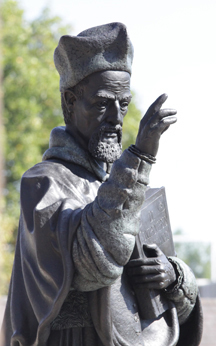 Bellarmine College was opened on October 3, 1950, under the sponsorship of
the Roman Catholic Archdiocese of Louisville and with the special assistance of
the Conventual Franciscan Fathers. It followed third in a proud line of diocesan
institutions of higher learning founded by this diocese, the oldest in inland
America. The earlier predecessors were St. Joseph's College in Bardstown
(1820-1889), which was closed in the 1860's by the tumult of the Civil War, and
St. Mary's College near Lebanon begun in 1821, which functioned as a liberal
arts college until 1929 and exclusively as a seminary until 1975.
Bellarmine College was opened on October 3, 1950, under the sponsorship of
the Roman Catholic Archdiocese of Louisville and with the special assistance of
the Conventual Franciscan Fathers. It followed third in a proud line of diocesan
institutions of higher learning founded by this diocese, the oldest in inland
America. The earlier predecessors were St. Joseph's College in Bardstown
(1820-1889), which was closed in the 1860's by the tumult of the Civil War, and
St. Mary's College near Lebanon begun in 1821, which functioned as a liberal
arts college until 1929 and exclusively as a seminary until 1975.
The Bellarmine campus of today stands on property that was a part of a royal
land grant from King George III to James McCorkle for his service in the French
and Indian War. When the American Republic was born, the land was retitled by
Thomas Jefferson, Governor of Virginia, of which Kentucky was then a part.
During the antebellum period, on this land stood a Manor House owned by the Griffin
family, who, impoverished by the Civil War, sold the estate to Bishop William
George McCloskey for a seminary, Preston Park, which opened in 1871 and lasted,
with interruptions, until 1909. During the Civil War, the Griffin estate house
served as a military hospital. Old Preston Park also served at times as
orphanages staffed by the Sisters of Charity of Nazareth: St. Vincent's for
girls (1892-1901) and St. Thomas for boys (1910-1938).
In 1950, the year of Bellarmine's inception, the new school became one of the
first in the Commonwealth of Kentucky open to all races. The first forty-two
graduating seniors, "The Pioneer Class," received their diplomas in 1954. In
1968, Bellarmine merged with Ursuline College, a Catholic college for women
established by the Ursuline Sisters of Louisville in 1938. It was at the time of
merger that the traditional student body became coeducational (the evening
division was coeducational already), and Bellarmine became independent with a
self-perpetuating governing board.
In 1963, Bellarmine opened the Thomas Merton Studies Center devoted to the works of Thomas Merton, a monk at the Abbey of Gethsemani. Today this internationally significant archive contains over 20,000 items; over 100 doctoral dissertations plus masters theses and numerous books have been written based in part on work at Bellarmine's Center. In the spring of 1997, the Thomas Merton Center moved into the second floor of the W. L. Lyons Brown Library into a suite designed to house the collections and provide space for scholars to meet and work.
Bellarmine began its first graduate program, the Master of Business Administration, in 1975. Today the University also offers graduate degree programs in Communication, Education, Nursing, Physical Therapy, Executive MBA, and a dual MSN/MBA masters degree.
In 2000, the Board of Trustees voted to change the name of the institution from Bellarmine College to Bellarmine University to reflect its true status as a Master’s I university. Today Bellarmine University is made up of Bellarmine College of Arts and Sciences, the College of Health Professions, the W. Fielding Rubel School of Business, the Annsley Frazier Thornton School of Education, and the School of Continuing and Professional Studies.
Bellarmine University is situated on approximately 135 acres of gently rolling terrain through which Louisville’s historic Beargrass Creek flows.
During the 1990s, a number of construction projects were completed: Petrik Hall, a six story residence hall that houses 134 students in comfortable and attractive suites; Miles Hall, a 26,500-square-foot classroom and office building for the nursing and health science programs; and the centerpiece of campus, the W. L. Lyons Brown Library.
In 2001, Bellarmine added Our Lady of the Woods Chapel, Bellarmine University Campus Center, Anniversary Hall, the Sports, Recreation and Fitness Center; and major renovations to Pasteur, Miles, and Lenihan Halls. During this time, Bellarmine also added four new degree programs in the Health Sciences respiratory therapy, cytotechnology, and clinical laboratory science, and the masters degree in physical therapy - providing students a wider, richer selection of academic programs and strengthening all of the sciences at Bellarmine.
In the new millennium, many major building projects have been completed and dedicated: Our Lady of the Woods Chapel in the wooded area above Newburg Road; Anniversary Hall, a 200-bed residence hall; Siena Primo, Siena Secundo, Siena Terzo, and Siena Quarto, a complex of new residence halls; Owsley B. Frazier Stadium; the transformation of the Campus Tennis Club into the Bellarmine Sport, Recreation and Fitness Center; creation of the Eddie Weber Tennis Complex; major expansions of the University Dining Hall and of the School of Communication; and the 28,500-square-foot Norton Health Science Center. In 2017, the university opened Bellarmine Centro and McGowan Hall, a 47,300-square-foot campus center, which includes a new welcome and admissions center, career center, center for campus ministry and classrooms.